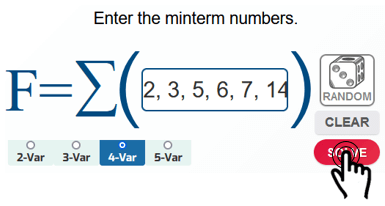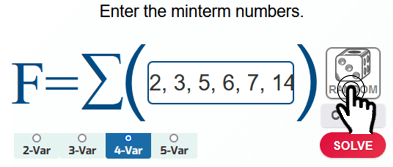- Calculators
- Digital Systems
- Minterms-Maxterms
MINTERM TO MAXTERM CONVERTER
MINTERM TO MAXTERM CONVERTER
Enter the minterm numbers.
∑(2, 3, 5, 6, 7, 14) = ∏(0, 1, 4, 8, 9, 10, 11, 12, 13, 15)
SOLUTION
Use the product symbol for the maxterms.
∏(...)
There are 4 variables in the function. Write down the numbers from 0 to 24 – 1 = 15 inside the parantheses that are missing in the minterm notation.
∏(0, 1, 4, 8, 9, 10, 11, 12, 13, 15)
OTHER INFORMATION
If the Boolean functions are A, B, C and D the sum of minterms can be represented as shown below.
F(A, B, C, D) = ∑(2, 3, 5, 6, 7, 14)
= A'B'CD' + A'B'CD + A'BC'D + A'BCD' + A'BCD + ABCD'
The same function can be written in the form of the product of maxterms as illustrated below.
F(A, B, C, D) = ∏(0, 1, 4, 8, 9, 10, 11, 12, 13, 15)
= (A + B + C + D)(A + B + C + D')(A + B' + C + D)(A' + B + C + D)(A' + B + C + D')(A' + B + C' + D)(A' + B + C' + D')(A' + B' + C + D)(A' + B' + C + D')(A' + B' + C' + D')
MINTERMS AND MAXTERMS
The tables below show the minterm and maxterm expressions for 2, 3, and 4 Boolean variables, respectively. Each row contains the possible values of these variables and the corresponding minterm and maxterm expressions for those values.
Table 1: Table of minterms and maxterms for 2 variables.
| Variables | Minterms | Maxterms | |||
|---|---|---|---|---|---|
| A | B | Term | Notation | Term | Notation |
| 0 | 0 | A'B' | m0 | A + B | M0 |
| 0 | 1 | A'B | m1 | A + B' | M1 |
| 1 | 0 | AB' | m2 | A' + B | M2 |
| 1 | 1 | AB | m3 | A' + B' | M3 |
Table 2: Table of minterms and maxterms for 3 variables.
| Variables | Minterms | Maxterms | ||||
|---|---|---|---|---|---|---|
| A | B | C | Term | Notation | Term | Notation |
| 0 | 0 | 0 | A'B'C' | m0 | A + B + C | M0 |
| 0 | 0 | 1 | A'B'C | m1 | A + B + C' | M1 |
| 0 | 1 | 0 | A'BC' | m2 | A + B' + C | M2 |
| 0 | 1 | 1 | A'BC | m3 | A + B' + C' | M3 |
| 1 | 0 | 0 | AB'C' | m4 | A' + B + C | M4 |
| 1 | 0 | 1 | AB'C | m5 | A' + B + C' | M5 |
| 1 | 1 | 0 | ABC' | m6 | A' + B' + C | M6 |
| 1 | 1 | 1 | ABC | m7 | A' + B' + C' | M7 |
Table 3: Table of minterms and maxterms for 4 variables.
| Variables | Minterms | Maxterms | |||||
|---|---|---|---|---|---|---|---|
| A | B | C | D | Term | Notation | Term | Notation |
| 0 | 0 | 0 | 0 | A'B'C'D' | m0 | A + B + C + D | M0 |
| 0 | 0 | 0 | 1 | A'B'C'D | m1 | A + B + C + D' | M1 |
| 0 | 0 | 1 | 0 | A'B'CD' | m2 | A + B + C' + D | M2 |
| 0 | 0 | 1 | 1 | A'B'CD | m3 | A + B + C' + D' | M3 |
| 0 | 1 | 0 | 0 | A'BC'D' | m4 | A + B' + C + D | M4 |
| 0 | 1 | 0 | 1 | A'BC'D | m5 | A + B' + C + D' | M5 |
| 0 | 1 | 1 | 0 | A'BCD' | m6 | A + B' + C' + D | M6 |
| 0 | 1 | 1 | 1 | A'BCD | m7 | A + B' + C' + D' | M7 |
| 1 | 0 | 0 | 0 | AB'C'D' | m8 | A' + B + C + D | M8 |
| 1 | 0 | 0 | 1 | AB'C'D | m9 | A' + B + C + D' | M9 |
| 1 | 0 | 1 | 0 | AB'CD' | m10 | A' + B + C' + D | M10 |
| 1 | 0 | 1 | 1 | AB'CD | m11 | A' + B + C' + D' | M11 |
| 1 | 1 | 0 | 0 | ABC'D' | m12 | A' + B' + C + D | M12 |
| 1 | 1 | 0 | 1 | ABC'D | m13 | A' + B' + C + D' | M13 |
| 1 | 1 | 1 | 0 | ABCD' | m14 | A' + B' + C' + D | M14 |
| 1 | 1 | 1 | 1 | ABCD | m15 | A' + B' + C' + D' | M15 |
Any boolean function can be expressed in the sum of minterms and the product of maxterms forms. These forms can be expressed with terms like F(A, B) = A'B + AB' or F(A, B) = (A + B)(A' + B') and with numbers like F(A, B) = ∑(1, 2) or F(A, B) = ∏(0, 3). In the second notation the numbers within the parentheses are the subscripts of the minterms or maxterms in the first notation. For example, the minterms in the expression F(A, B) = A'B + AB' are m1 and m2. So the numbers 1 and 2 should appear in the parentheses.
The conversion between cannonical forms is quite easy. Assuming that n is the number of variables, we enumerate all numbers from 0 to 2n – 1. To convert the sum of minterms into the product of maxterms form, we note down the numbers that are not in the minterm list and write them into the maxterm list.
The calculator above converts the sum of minterms into the product of maxterms form. If you are looking for the product of maxterms to sum of minterms conversion, please click here.
INPUT FORMAT
Enter the minterms separated by commas or spaces.
WHAT IS MINTERM TO MAXTERM CONVERTER?
Minterm to maxterm converter,
- Find the product of maxterms representation of the function,
- Constructs the explicit form of the sum of minterms expression assuming the Boolean varaibles are A, B, C and etc. and
- Constructs the product of maxterms expression.
HOW TO USE THE MINTERM TO MAXTERM CONVERTER?
Minterm to maxterm converter can be used in two ways.
USER INPUTS

You can enter the minterm numbers to the input box and click on the "CONVERT" button. The result and explanations appaer below the calculator.
RANDOM INPUTS

You can click on the DIE ICON next to the input box. If you use this property, a set of minterm numbers are generated and entered to the calculator, automatically. The result and explanations appaer below the calculator. You can create your own examples and practice using this property.
CLEARING THE INPUT BOX

To find the maxterms corresponding to the entered minterms, you can clear the input box by clicking on the CLEAR button.
COPYING & DOWNLOADING THE SOLUTION

You can copy the generated solution by clicking on the "Copy Text" link, appaers under the solution panel.

Even you can download the solution as an image file with .jpg extension if you click on the "Download Solution" link at the bottom of the solution panel. You can share the downloaded image file.

- Calculators
- Digital Systems
- Minterms-Maxterms
MINTERM TO MAXTERM CONVERTER
RELATED LINKS
MINTERMS AND MAXTERMS
FUNCTION TO SUM OF MINTERMS CONVERTER
FUNCTION TO PRODUCT OF MAXTERMS CONVERTER
FUNCTION TO CANONICAL FORMS CONVERTER
KARNAUGH MAP SOLVER FOR MINTERMS (SUM OF PRODUCTS)
KARNAUGH MAP SOLVER FOR MINTERMS (PRODUCT OF SUMS)
KARNAUGH MAP SOLVER FOR MINTERMS (WITH DON'T CARES-SUM OF PRODUCTS FORM)
KARNAUGH MAP SOLVER FOR MINTERMS (WITH DON'T CARES-PRODUCT OF SUMS FORM)
KARNAUGH MAP SOLVER FOR MAXTERMS (SUM OF PRODUCTS)
KARNAUGH MAP SOLVER FOR MAXTERMS (PRODUCT OF SUMS)
KARNAUGH MAP SOLVER FOR MAXTERMS (WITH DON'T CARES-SUM OF PRODUCTS FORM)
KARNAUGH MAP SOLVER FOR MAXTERMS (WITH DON'T CARES-PRODUCT OF SUMS FORM)
MINTERM TO MAXTERM CONVERTER
MAXTERM TO MINTERM CONVERTER
MINTERM TO TRUTH TABLE CONVERTER
MAXTERM TO TRUTH TABLE CONVERTER
TRUTH TABLE TO MINTERM CONVERTER
TRUTH TABLE TO MAXTERM CONVERTER